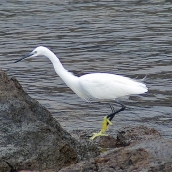Little Egret (Egretta garzetta)
This member of the heron family measures 55-65 cm in total length, with a wingspan of 88-106 cm. It is pure-white and has long black legs and yellow toes. The bill is dark grey, with a yellow base. In Macaronesia it only breeds in the Canaries (Lanzarote and occasionally Tenerife) and Cape Verde (Santa Luzia, Raso, São Nicolau, Sal and Boavista, and perhaps on São Vicente and Branco), but is seen regularly throughout all the island groups during migration and winter seasons. It also roosts in Morocco and other sectors of continental Africa, Europe, the Middle East, Asia and Australia. It inhabits low-lying coastal areas and wetlands (ponds, dams, sea lagoons), but builds its nest in trees, on cliffs or on the ground, and sometimes in thickets. It feeds on aquatic insects, small fish, frogs and the occasional young lizard. In the Canaries the breeding season begins in February, whereas in Cape Verde it extends from March to July; clutches of 2-5 eggs are produced. Colonies in Macaronesia consist of 15 pairs at most, and in Lanzarote this bird has roosted alongside a sizable population of cattle egret (Bubulcus ibis). During migration and winter seasons, large colonies of 100-200 individuals have been recorded in the Canaries. They usually arrive in August or September and gradually increase in size until well into the autumn. There are several communal roosting flocks of this species, located on cliffs and coastal rocks and islets, woody areas and reed beds near inland ponds, or even on partially sunken vessels at sea. The population on Cape Verde has been estimated at around 500 pairs, while in the Canaries, current breeding pairs may number 5-10. Main threats include tree-felling and the clearance of reed beds where these birds shelter or nest, changes in pond water levels, human encroachment and the use of chemical products in the bird’s habitat.













